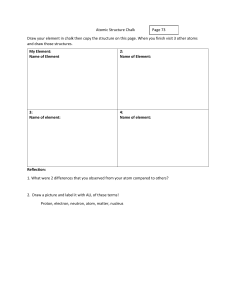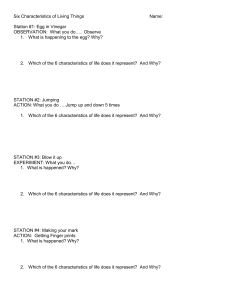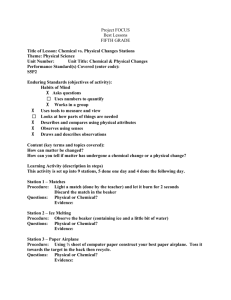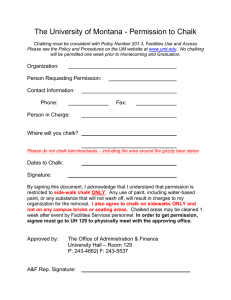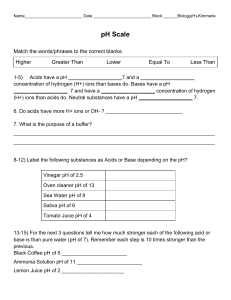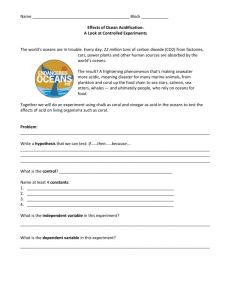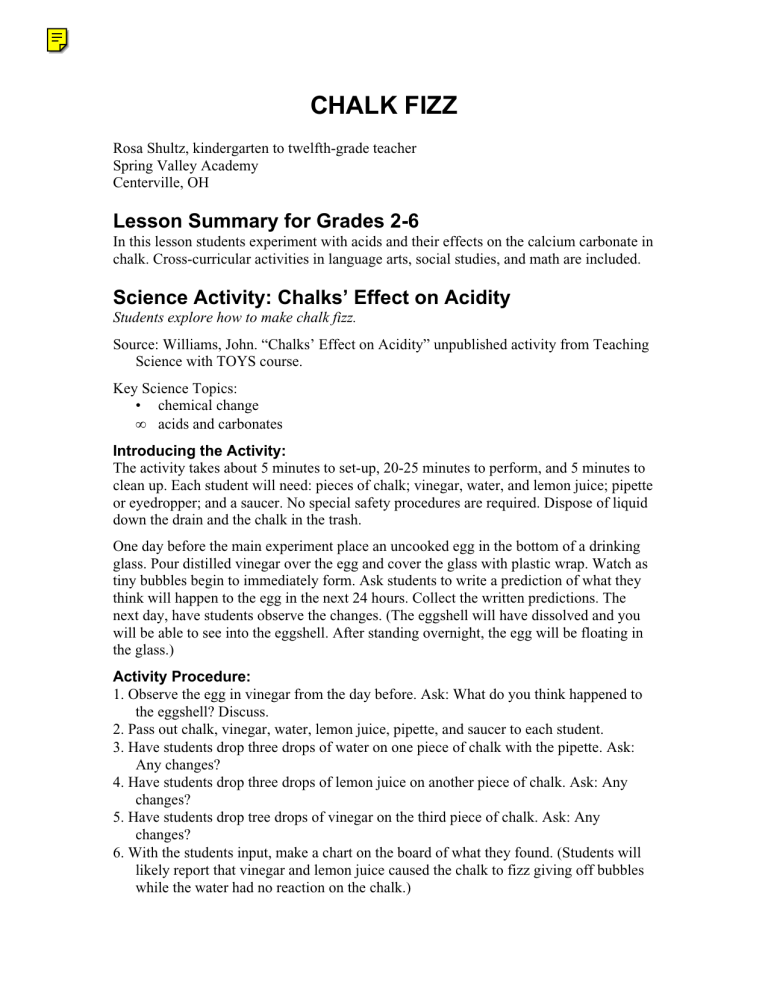
CHALK FIZZ Rosa Shultz, kindergarten to twelfth-grade teacher Spring Valley Academy Centerville, OH Lesson Summary for Grades 2-6 In this lesson students experiment with acids and their effects on the calcium carbonate in chalk. Cross-curricular activities in language arts, social studies, and math are included. Science Activity: Chalks’ Effect on Acidity Students explore how to make chalk fizz. Source: Williams, John. “Chalks’ Effect on Acidity” unpublished activity from Teaching Science with TOYS course. Key Science Topics: • chemical change • acids and carbonates Introducing the Activity: The activity takes about 5 minutes to set-up, 20-25 minutes to perform, and 5 minutes to clean up. Each student will need: pieces of chalk; vinegar, water, and lemon juice; pipette or eyedropper; and a saucer. No special safety procedures are required. Dispose of liquid down the drain and the chalk in the trash. One day before the main experiment place an uncooked egg in the bottom of a drinking glass. Pour distilled vinegar over the egg and cover the glass with plastic wrap. Watch as tiny bubbles begin to immediately form. Ask students to write a prediction of what they think will happen to the egg in the next 24 hours. Collect the written predictions. The next day, have students observe the changes. (The eggshell will have dissolved and you will be able to see into the eggshell. After standing overnight, the egg will be floating in the glass.) Activity Procedure: 1. Observe the egg in vinegar from the day before. Ask: What do you think happened to the eggshell? Discuss. 2. Pass out chalk, vinegar, water, lemon juice, pipette, and saucer to each student. 3. Have students drop three drops of water on one piece of chalk with the pipette. Ask: Any changes? 4. Have students drop three drops of lemon juice on another piece of chalk. Ask: Any changes? 5. Have students drop tree drops of vinegar on the third piece of chalk. Ask: Any changes? 6. With the students input, make a chart on the board of what they found. (Students will likely report that vinegar and lemon juice caused the chalk to fizz giving off bubbles while the water had no reaction on the chalk.) 7. Discuss the egg in vinegar again and again ask: What do you think happened to the eggshell? Explanation: Acid is the name of a group of chemical compounds with common characteristics. Vinegar and lemon juice are acids. Household vinegar is usually only about 3-6 percent acetic acid. Most white classroom chalk is made of a rock called limestone, which contains calcium carbonate (CaCO3). Limestone forms on the bottom of seas from seashells. Acids react quickly with carbonates. The acid breaks apart the calcium and the carbonate to from calcium (Ca) and carbon dioxide (CO2). In this experiment, a chemical change occurs when the acid (vinegar or lemon juice) reacts with the calcium carbonate (chalk). In this chemical change, a new substance is produced: the gas carbon dioxide that produces the fizzing bubbles. In all chemical changes, the properties of the affected subject are lost. In this experiment the acidic property of vinegar or lemon juice is lost. Language Arts Activity Students read about acid rain and then write persuasive letters. Choose materials related to acid rain. Students research current information available on acid rain and then write “letters to the editor” expressing their opinions on acid rain. Ohio Proficiency Learning Outcomes for Fourth Grade: • Reading Strand IV: 19 a, b. • Writing Strand IV: Writing Conventions 7, 8, 9. Social Studies Activity Students investigate the effects of acid rain. Students read about acid rain and its effect on their community, state, country, and world. Ohio Proficiency Learning Outcomes for Fourth Grade: • Citizenship Strand VI: Citizens Rights And Responsibilities 16, 17. Math Activity Students create a chart. Students complete a chart to record information on acids, bases, and neutral substances. Ohio Proficiency Learning Outcomes for Fourth Grade: • Math Strand VIII: Data Analysis and Probability 24. References “Acetic Acids,” World Book Encyclopedia.1997, p 25. “Acids,” World Book Encyclopedia. 1997, pp 26-27. Gardner, Robert. Science Projects About Chemistry; Enslow: Springfield, NJ, 1994. Moje, Steven. Cool Chemistry; Sterling: New York, 1999. Potter, Jean. Science in Seconds with Toys; Wiley and Sons: New York, 1998; p 22.
